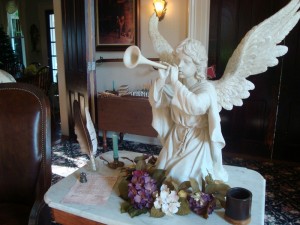I dealt with the furs today. I went to Mesahekow Furs in Waterford with the mink, the muskrat, the persian lamb, the black rabbit, the Russian squirrel stole and the formerly white bunny wraps (they are yellowed now, like rabbits who need a bath). Since my mother’s death in 2008, I kept her furs in the same cedar closet where they had lived for years. Downsizing furs is not easy. I don’t wear fur, but these felt like my mother’s pets. I’m feeling sentimental about a bunch of dead animal skins or perhaps I need to honor my mother’s eccentricities.
The showroom at Mesahekow’s had the temperature and mysterious darkness of a wine cellar and might have been painted pale blue except the walls were in shadow. This is the only furrier within one hundred miles of the cedar closet. The spot lighting here and there cast light only in certain directions, highlighting ghostly fur-clad mannequins and creating dark corners in the rest of the room like the interior of a ship sailing near Antarctica in the endless night winter season or some other frozen place. Furs need to be cold and I suppose if the room was warm no one could be enticed to try on one of these dead creatures. In cold and darkness fur feels warm and safe. An igloo atmosphere, cave-like, makes it enticing. Fur bespeaks luxury and survival. Capturing, skinning, preserving this amount of warmth against snow and ice could be the difference between the life and death of a hunter.
Nate, the furrier in charge, didn’t look like much of a hunter but he understood fur. His eyes narrowed as he examined my collection as if he was peering through a microscope at individual hairs. During my visit, he received several cell phone calls. People to whom he said things like, “he must be stressed out” or “let me call you back in a few minutes.” A family business, I thought. I had assumed this was “Nate.” There was a parking spot outside that said, “reserved for Nate Mesahekow” and he was the only person in the shop. I imagined him to be the descendent of generations of furriers with his dyed jet black hair and his stomach protruding over his belt. His hair appeared dyed to me because it lay like a pelt on his head, a solid color without the variations of real hair or fur. Perhaps he is the end of a dynasty. Fur has lost its usefulness with the creation of down-filled jackets and other cold proof materials. Here in this furry world, fur vests hung on racks, and long and short style mink jackets and coats rested on mannequins who wore nothing except furs; not even a satin slip. They had soft, nude-colored bodies and I was convinced that I would look like them if I was naked and wearing only fur. Perhaps it was an illusion, but the image was convincing. I would be rich and beautiful and thinner if I wore one of these. My mother’s dream was to drive a Cadillac while wearing her mink coat.
A super-soft, dazzling white fur scarf – perhaps fox tail – was draped across one of the many dark brown leather chairs. Animal skin ruled here. Light brown, dark brown, yellow brown, black, long-haired reds, grey, puffy beige. I asked if my mother’s full-length autumn haze mink could be made into a lining for a coat with a cloth exterior but Nate wasn’t enthusiastic. Make a vest, he suggested. It’s the style right now. “People love them. They say they can wear them all the time,” he said.
But that would mean cutting off the mink arms and shortening the coat, I thought. Wouldn’t I be wasting a lot of perfectly good mink? Perhaps it’s a lot of work to make a coat lined with fur and easier to make vests. Nate’s sagging face looked tired.
“Let me show you where we sew,” he said. We went through a doorway into a dark workroom where he pointed to examples of the fur vests that everyone loves. When the fluorescent lights came on, we were in a fur morgue. I saw piles of fur on the floor and clothing racks crammed with stoles, and shelves of fur hats next to a row of sewing machines. The room smelled dense and mossy like a cave or many armpits.
I was happy to return to the cool openness of the showroom where Nate finally examined all my inherited pets and gave the death sentence to the muskrats and the curly, silvery grey Persian lamb. “Dry,” he said. It seems that once the skin dries it just cracks and disintegrates when you try to work with it. “Give it to the salvation army,” he said.
What in the world does the salvation army do with dry cracked fur? I wondered. I couldn’t make any more decisions so he suggested that the others, the survivors, go into storage. He will clean and “glaze” them and I can decide later what to do with them. I felt I was leaving mom’s beloved pets at an animal shelter. How will they be when I see them again? Will we recognize each other? My mother would never agree to this.

